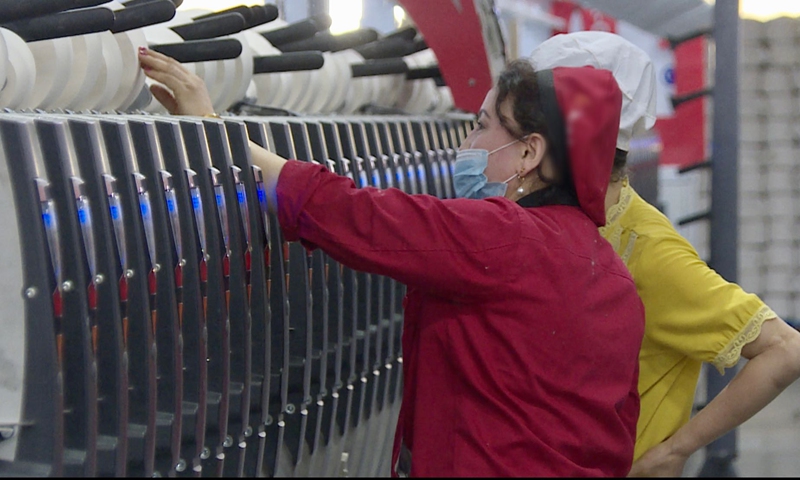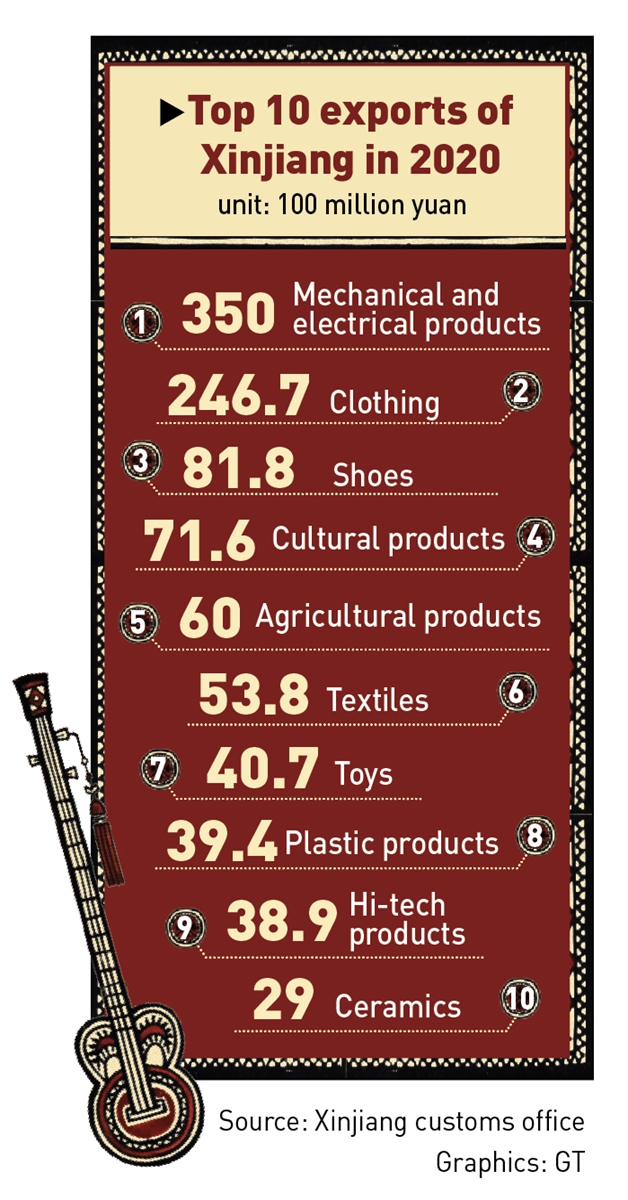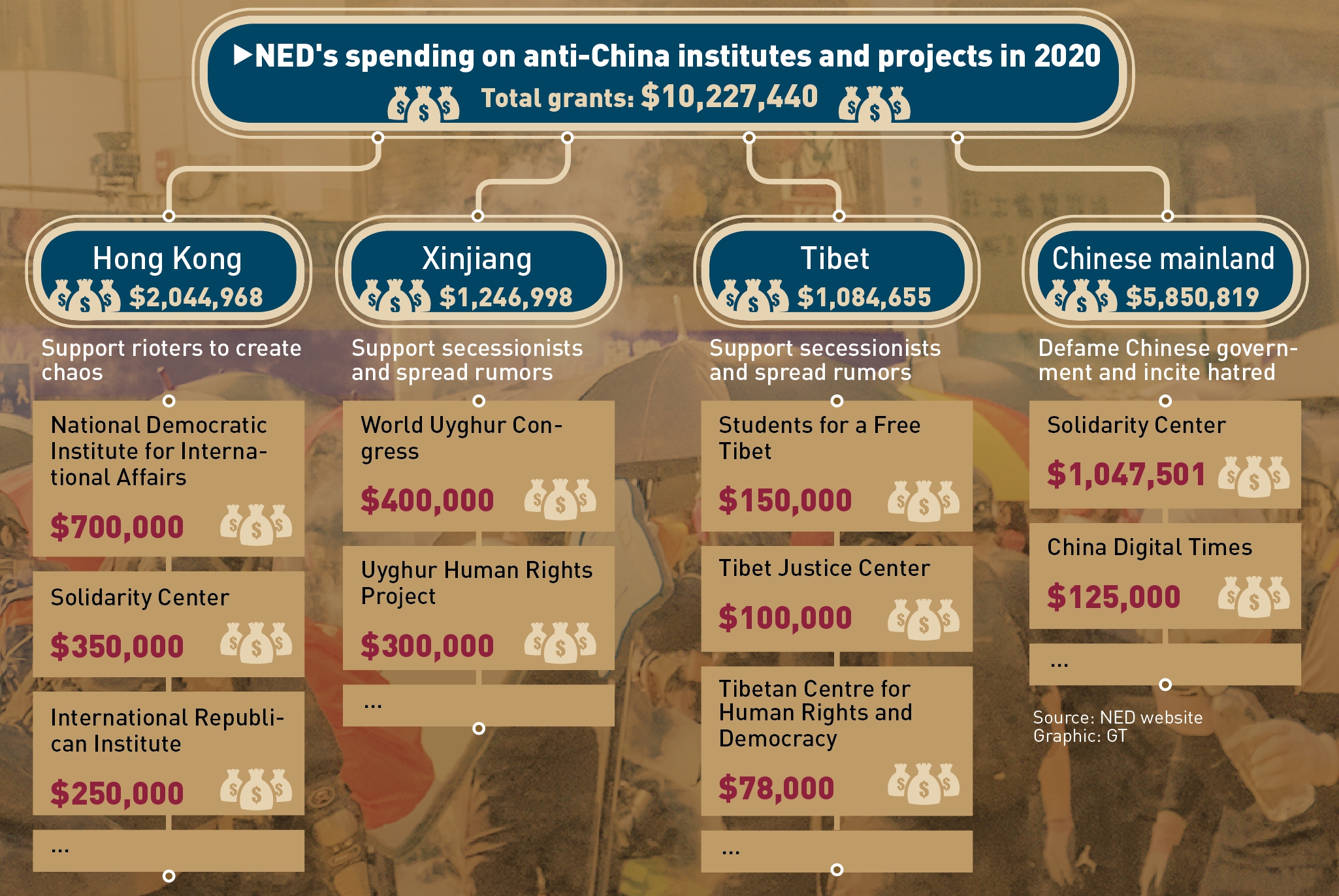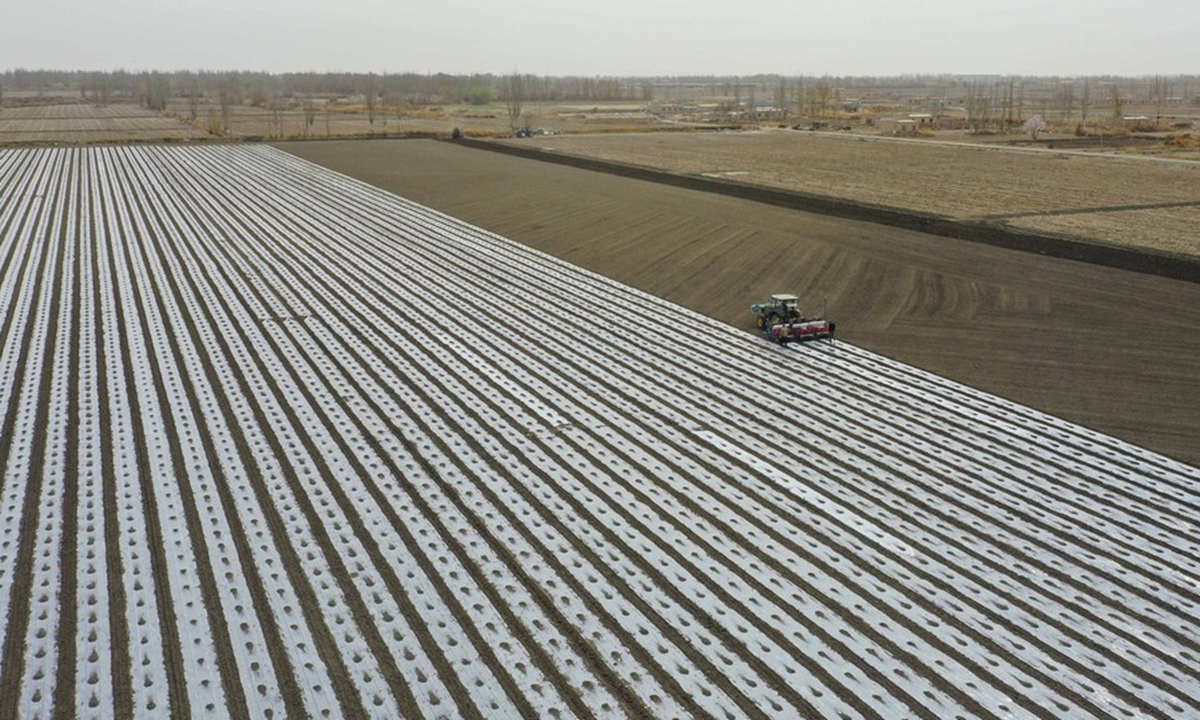Xinjiang PV enterprise refutes unfounded Bloomberg report on irresponsible accusation of ‘forced labor’, plots ‘industry stifling’ in Xinjiang, this time targets solar energy industry - Global Times
First it was cotton; now it's Xinjiang's solar panels that are being targeted. Both are pillar industries of Xinjiang in Northwest China, and they have become the target of what appears to be a malicious campaign launched by Western anti-China forces to destroy Xinjiang's rapidly ascending economy and ultimately obstruct the development of China.
These forces behind the campaign position themselves as saviors and claim to counter a "genocide" in Xinjiang, but what they are doing is essentially attempting to wipe out the industries and the bread and butter of over 25 million people in Xinjiang, locals, businesses and experts said.
Unlike the campaign against Xinjiang's cotton, which was led by political forces, the latest campaign against the photovoltaic (PV) industry appears to be pushed by forces within the PV industry that have been overwhelmed by Chinese firms, including those in Xinjiang, for years, in an apparent ill attempt to use politics to crack down on what they can't compete with in the market, analysts pointed out. Such a shift in trend poses a serious threat for other industries in Xinjiang and around the country and demands forceful countermeasures, they said.
As the debate on the so-called forced labor issue in the Chinese solar energy industry has been hyped up lately following the West's groundless smearing on Xinjiang cotton, Chinese experts and solar energy insiders warned that the US is setting a trap and a pattern, step by step, to destroy Xinjiang's competitive industries, even with an aim to bring about the collapse of Xinjiang's economy and local people's livelihood.
.
Once finding the approach of giving a bad name to the Chinese industry useful by citing "human rights abuses" or "forced labor," capital and interest groups may copy the smearing and boycott approach to stifle Xinjiang's industries, experts warned.
The Global Times interviewed a local polysilicon giant and found that the so-called forced labor in the region's PV industry is simply another lie created by certain media outlets, US trade groups and politicians.
"The workers from ethnic minority groups are mainly hired online, from universities and colleges, talent markets and by employee referrals. They enjoy paid annual leave, home visits with subsidies, wedding cash gifts, year-end bonuses and holiday gifts," Zhang Longgen, deputy chairman of Xinjiang Daqo, one of the four major Chinese polysilicon manufacturers, told the Global Times, denying any employment from Xinjiang's vocational education and training centers as reported by Bloomberg, the New York Times, POLITICO and so on.
Xinjiang Daqo's production accounted for around 15 percent of the global market share in 2020. "Silicon wafer producers are the customers of polysilicon. Around 97 percent of the global silicon wafers are made in China. All our products are sold in China," Zhang said.
"The ridiculous thing is that the US forcibly distorts facts and smears all the good things we have done that benefited the ethnic minority groups in Xinjiang," Zhang said.
By doing so, the US would strike a blow to China's, even the world's, solar energy sector and hurt the interests of ethnic groups in Xinjiang, he said.
At Xinjiang Daqo, 18 out of 1,934 workers are from ethnic minority groups. The average monthly salary at Xinjiang Daqo is 7,300 yuan ($1,118), compared with the average monthly salary of 6,617 yuan in Xinjiang's non-private sector and 3,825 yuan in the private sector in 2019.
"The proportion of labor costs in our company is less than 7 percent, so polysilicon manufacturing is not a labor-intensive industry," Zhang pointed out.
Dismissing a Bloomberg report on Tuesday which said "there's no freedom to refuse to sign factory contracts" for workers in Xinjiang, Zhang said some Western media's reports on Xinjiang came out of the reporters' "fertile imagination."
"Forced labor is not only unethical but also illegal in China. We have examined our suppliers recently and found no behavior of 'forced labor,'" Zhang said, adding the company's employee turnover rate is less than 3 percent.
"Anyone who tries to put a label of 'forced labor' on the Chinese PV enterprise should show their evidence. For example, who is forced to work in which enterprise? Without giving any testimony, such a claim is very irresponsible," Zhang said.
In a Bloomberg report, it said "guards in brown camouflage ordered away would-be observers" at the Xinjiang Daqo facility. The company told the Global Times it has been always open for visitors, but the coronavirus reduced such activities in the past year. "Bloomberg contacted us before Spring Festival this year, but China's epidemic control and prevention was strict at that time. That's why we didn't host it.
Echoing Zhang, a 39-year-old ethnic Mongolian worker named Bajin, said the so-called forced labor has never existed in the factory since he came to work for the company in May 2011, and none of his friends have ever complained about being forced to work in Xinjiang.
"I work eight hours per day and get two days off per week. I feel workers from ethnic minority groups at our company can even get extra care from our supervisors. So the Western countries' smearing is intentional to disturb ethnic unity in Xinjiang as well as our country's fast development," Bajin told the Global Times.
"For people at my age in Xinjiang, we all long for a good life, by farming, working or running our own businesses to improve our life quality. 'Forced labor' doesn't exist," he said, adding he earns 9,000 yuan per month as a production safety management staff member.
Smearing campaign
Zhang said he had smelled the conspiracy in the air for months, as he noticed that the share price of the US-listed Daqo New Energy Corp, the parent company of Xinjiang Daqo, dive from $130 to the current $67, dropping by approximately 52 percent in just two months.
Another Chinese PV giant Jinko Solar also suffered from short selling at the US stock market.
"We expressed strong condemnation to the groundless and irresponsible media reports that turned things upside down," Zhang noted.
The pace interestingly is in line with a report released in a publication by consulting firm Horizon Advisory in January, which claimed that "forced labor" is being used in the Chinese PV supply chain.
On top of that, the Solar Energy Industries Association (SEIA), the US national trade group, urged its members to move their supply chains out of Xinjiang. More than 170 companies have signed a nonbinding pledge to avoid the so-called forced labor.
Xinjiang produces around 45 percent of the world's polysilicon supply - a type of upstream raw material in the photovoltaic (PV) industry, according to Dai Yanling, a veteran PV practitioner in China. Requiring intensive energy, such material is largely churned out in places that have large amounts and cheap electricity, thermal power and PV energy. That made Xinjiang, Southwest China's Yunnan, as well as North China's Inner Mongolia appealing in polysilicon manufacturing. China accounts for more than 85 percent of the world's polysilicon supply.
"Polysilicon manufacturing is not a labor-intensive industry anymore. Labor costs are not a key factor," Dai said.
US Senators Marco Rubio, Rick Scott and others introduced the so-called "Keep China Out of Solar Energy Act" at the end of March in quick succession, banning US federal funds from being used to buy solar panels from companies based in China.
It is clear that the US has a map to crack down on China's PV industry, as it first started from a trade group's instigation, then to a further upgrading by US politicians, and "the reason behind it is that China's rapid growth in the solar energy sector moved the cheese of US companies," Dai said.
Dai said that before 2010, the polysilicon used in global solar energy had been monopolized by US and German enterprises, which had profiteered Chinese PV firms by forcing the them to sign long-term contracts (some are 10 years) with them.
Over more than a decade after China ramped up efforts in developing the PV industry, the price of polysilicon has dropped from $400-500 per kilogram in foreign companies before 2010 to $20 per kilogram in Chinese companies now, the practitioner noted.
Even if the US is the place of origin of PV technologies, its current PV sector lags behind when compared with developed countries like Germany, Japan and developing countries like China. Such a situation worried the US PV practitioners, Dai added.
To beat down the Chinese PV industry, the US government has taken different actions, such as in 2012, the US Department of Commerce imposed levies of 31.14-249.96 percent anti-dumping duties on Chinese PV cells while China's growth in solar energy was forging ahead.
Global Times reporters also found out over the past two years that many US business and trade representatives have cited the PV industry as a "classic case" when talking about the China-US trade frictions.b
The duties and crackdown policies have not beaten down China's PV industry, which disappointed the US.
According to the SEIA, the US PV industry was at a standstill during the Trump administration, with its PV install capacity dropping in the first two years during his term of office. After the relevant taxation reducing policy, the PV industry recovered a little in the US.
The first thing pushed forward by the incumbent US President Joe Biden was to get back to the Paris Agreement and set strategic goals in the energy sector.
Analysts said that in addition to strengthening the efforts to combat climate change, his aim was also to catch up the pace in the PV sector with other countries and even regain an upper hand, as major countries around the world embrace a green future in front of the crisis of global warming and climate change.
What also concerned the US businessmen is the US' high dependency on China in the PV supply chain, as Chinese companies have both lower costs and technological superiority, particularly in large size silicon wafers and granular silicon.
According to a report by McKinsey & Co in 2018, China's PV industry competitiveness surpassed the US by a lot. Among the top 10 global PV modules enterprises in 2020, three came from China and only one came from the US.
Zhang also cited statistics from the China Photovoltaic Industry Association to prove the country's PV supply could make tremendous contributions to the world's renewable energy transformation: Chinese raw material of silicon accounts for 67 percent of global share, wafers 97 percent, solar cells 79 percent and PV modules 71 percent.

Workers at a cotton textile factory in Aksu City, Xinjiang Uygur Autonomous Region, northwest China, March 29, 2021. (Photo/CGTN)
Destroying value chain
It looks like the tactics of the PV industry have some water splash.
In a list of questions regarding alleged "forced labor" in Xinjiang, several members of the Dutch parliament urged the Netherlands government to explain if it is aware that solar PV panels and other components imported from China may contain raw materials from Xinjiang, according to local media reports.
They also asked the government to explain the possible impact on Dutch and European renewable energy markets in such situation as imports of Xinjiang-produced solar modules would be suspended.
Regarding the previous action on Xinjiang cotton, and now the PV industry, which accounts for 80-90 percent of the world's PV modules supply, Chinese experts warned that other industries, such as mechanical and electrical products, electric power and petroleum, could also be the next targets, and the US government is trying to suffocate or even kill Xinjiang's outstanding industries, with the help of some other Western countries.

"It looks like the US wants Xinjiang's competitive industries to die out in the region, so far namely cotton and solar energy, but in fact, it is destroying China's participation in the global value chain," Wang Yao, a research fellow specializing in border areas at the Chinese Academy of Social Sciences, told the Global Times.
The exports of mechanical and electrical products in Xinjiang are also vibrant, and countries along the Belt and Road are the main buyers. In 2019, mechanical and electrical products championed the most popular exported goods in Xinjiang, with the export value hitting 33.79 billion yuan, accounting for 27 percent of the region's total exports.
Last but not least, they are copying the smearing approach on Xinjiang cotton onto the PV industry after the first trial was testified effective, Wang noted. "If so, China's PV sector may be kept out of the door by the US, even the world."
However, the tactics being used by US interest groups in slandering Xinjiang's PV sector is a little different from that for cotton. Unlike the crackdown on Xinjiang cotton which was initiated by politicians, the suppression of the PV sector began from companies and industry groups that initiated the accusation, then US politicians stepped in, showing the voluntary collusion between industrial capital and politicians in their mutual objective of cracking down on China's development, experts said.
Last year, amid the reports of alleged "forced labor," the US Fair Labor Association wrote a report on such a topic in January 2020. At that time, the Shanghai office of Switzerland-based Better Cotton Initiative (BCI) had examined cotton factories in Xinjiang and found no forced labor.
Clothing brands such as Adidas and H&M, which have cooperation with BCI, also conducted examinations in Xinjiang. H&M had stated that it found no clue of "forced labor" in factories in the Aksu Prefecture.
But on October 21, 2020, BCI announced on its website to cease all field-level activities in China's Xinjiang region.
Such a move was driven by pressure from outside, as well as other interests. Since member fees are the main financial source for BCI, brand members, including Nike, LEVIS, or GAP from the US, have a significant influence on BCI. The US Agency for International Development was once a council member.
After suffering pressure from multiple sources, including the US government, popular clothing brands declared they refused to source any cotton production from Xinjiang.
After seeing fruitful results of slandering Xinjiang cotton, the cards of Xinjiang human rights and "forced labor" might be a "master key" for the US to hit any industry of Xinjiang, Wang warned, saying electric power and petroleum are very likely to be the next targets.
"The choice of polysilicon is different from that of cotton, as the costs of cotton produced in China remain higher than that produced in the US, Brazil and Australia. That means, with the lower-cost advantage of PV products, this round of crackdown on Xinjiang polysilicon will not succeed," Gao Lingyun, an expert at the Chinese Academy of Social Sciences in Beijing who closely follows China-US bilateral trade, told the Global Times on Friday.
The photovoltaic industry appears to be the latest target caught up in the political farce orchestrated by anti-China .
Related posts:
West-backed color revolution a ‘top threat’ to China's national, political security

Only a US domestic revitalization plan that can forget about China will have any promise -When developing infrastructure,.
中美高层战略对话在即 美不行待客之道 中方严正回应! 20210319 |《今日关注》CCTV中文国际 中国核心利益没有退让余地 中美需避免零和博弈管控分歧 20210320 |《今日关注》CCTV中文国际 ..
Splashing $10m a year to split and subvert China, US govt-backed foundation unabashedly reveals funding scheme


 A worker installs a solar power unit at the construction site of a 300-MW photovoltaic electricity project of the China Datang Corporation Ltd. (Xinhua/Zhang Hongxiang)
A worker installs a solar power unit at the construction site of a 300-MW photovoltaic electricity project of the China Datang Corporation Ltd. (Xinhua/Zhang Hongxiang) 




